Greenland, the frozen island Trump has set his sights on
The U.S. president-elect’s interest has stirred a mix of fear and mistrust among Greenland’s inhabitants, while reigniting the long-standing debate over independence. In the capital city of Nuuk, it has become the talk of the town

A woman with Indigenous Inuit features, dressed as if she were preparing to conquer the North Pole, smiles at the new arrival, who looks like a foreigner and appears lost at the Nuuk airport, the capital of Greenland. She offers two pieces of advice. First, she tells him to walk like a penguin — slowly, with his feet close to the ground — to avoid slipping on the ice. Second, she shares the gossip of the day: everyone in the city of 20,000 inhabitants is talking about the recent visit of Donald Trump Jr., the son of the president-elect of the United States. Visits like this are rare in this remote, beautiful, frozen corner of the planet.
Trump’s son and advisor spent a few hours in Nuuk on Tuesday. He arrived aboard Air Force Trump, took photos with locals, handed out red “Make America Great Again” hats, visited the statue of Nuuk’s founder — Norwegian missionary Hans Egede, who arrived in 1721 — and dined at a downtown restaurant known for its grilled meat. He insisted that his visit was purely for tourism, not politics, but it coincided with a press conference in which his father, speaking from Mar-a-Lago, reiterated his stance that the United States should take control of Greenland, and said he would not rule out economic and military action to achieve this goal. Trump made his intentions clear before Christmas in a post on Truth Social: “For purposes of National Security and Freedom throughout the World, the United States of America feels that the ownership and control of Greenland is an absolute necessity.”
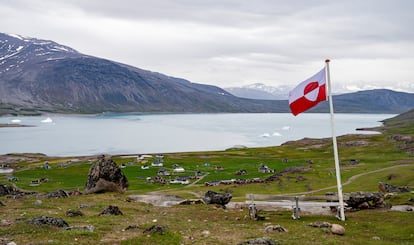
Greenlandic biologist Abbasy Lyberth, 53, heard the news at his parents’ home in the town of Qaqortoq, where he had traveled for Christmas. To reach the southern town of 3,000 residents, 280 miles from Nuuk, he and his family had to take two small planes — a journey that took two days. With no roads connecting towns and villages in Greenland, travel is done exclusively by plane or boat. “It’s more expensive to go to the town where I was born from Nuuk than to go to Copenhagen [the capital of Denmark],” he says.
Abbasy was both shocked and concerned by Trump’s warning. “I thought something was going to happen in Greenland. It’s true that Trump mentioned in 2019 that he wanted to buy the island, but now he is more prepared to do what he says. And he has more power. Something is coming. I’m afraid of what.” The biologist, who now advises the government on endemic birds of the island, is reserved, serious, and speaks slowly, carefully considering each word. Between sentences, he often pauses for long stretches of silence. In this, he is like the other Inuit people featured in this report. It seems to be a common Greenlandic trait — not speaking lightly, knowing that words carry weight and consequences. That, when in doubt, it is often better to remain silent.
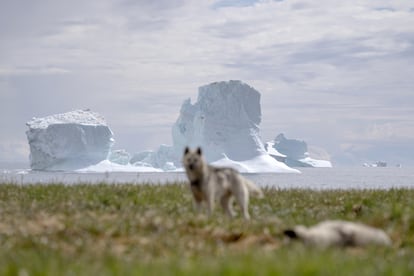
Everything in Greenland feels a bit like that — difficult to decipher. The vast, frozen landscape is overwhelming, and the numbers are disconcerting: the island is a massive rock, nearly entirely covered in ice, four times the size of Spain, yet only 57,000 people live there — nearly half the population of Albany. It is an autonomous territory within the Kingdom of Denmark, but Nuuk is closer to Washington than to Copenhagen. On winter days like today, temperatures can drop to 19 degrees below zero. It doesn’t get light until 11:30 a.m. and grows dark by 4 p.m. It’s striking to see an employee opening a downtown shopping center in the dead of night.
Doris Jacobsen, a Greenlandic member of parliament from the social-democratic Siumut party, has served as a member of the Danish Parliament and as a minister in various Greenlandic governments, overseeing areas such as culture, education, research, and health. After pondering the question, she responds: “Greenland is not for sale. But we are open to cooperating with nations that approach us. We do not want to be Americans, but we do not want to be Danish either.” In other words, Trump’s statements, warnings, and even threats have reignited the question of Greenland’s independence.
The inhabitants of Greenland suddenly find themselves at the center of the world’s attention, the object of desire for the most powerful man on earth. They are now searching for a way to leverage this interest without jeopardizing their identity or their future. A journalist, who prefers to remain anonymous, explains that the sudden attention his country is receiving — foreign reporters crowding the streets of Nuuk, Greenland’s name dominating international headlines — is both disorienting and stressful. Like Abbasy the biologist, he too received Trump’s statements with surprise and apprehension. Even a degree of alarm. “When he said in 2019 that he wanted to buy the island, it sounded like a joke. But now it doesn’t seem like a joke anymore. Trump is stronger now and appears more convinced.”
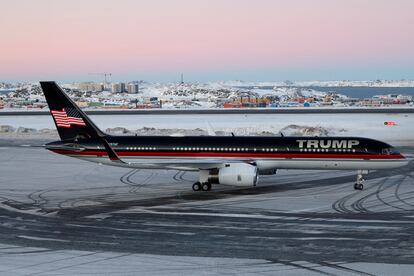
Jacobsen’s party governs Greenland in coalition with the Inuit Ataqatigiit, the winner of the 2021 elections. Both parties share a social-democratic ideology, though Inuit Ataqatigiit leans more toward ecological principles. Both are in favor of independence, but they differ when it comes to the pace at which they believe it should happen. Siumut, Jacobsen’s party, advocates for a faster approach. “We can be independent in 10 years,” Jacobsen calculates. In contrast, Inuit Ataqatigiit prefers a more gradual, step-by-step approach.
Biologist Abbasy, like everyone else in Greenland — including Jacobsen herself — is fully aware of the risks involved in such a move. Currently, about half of Greenland’s GDP is supported by the Danish government’s annual contribution of more than €600 million ($613 million) to the island’s budget. While Greenland’s economy is growing faster than the rest of Europe and unemployment is near 3%, these figures can be somewhat misleading, as 35% of jobs are in the public sector.
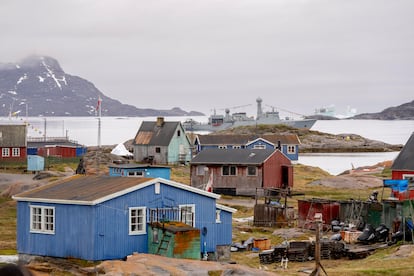
Greenland’s other main source of income comes from its fishing industry, which has long been central to the Inuit way of life, along with hunting. Shrimp, prawns, halibut, cod, and even whales are exported in large quantities to the United States and China, the island’s primary buyers. For example, Jacobsen’s husband is a whale hunter, reflecting the deep-rooted traditions of this country
Health care in Greenland is free and universal, though for certain treatments, residents must travel to Copenhagen for specialized procedures — almost five hours by plane. Education is also free, and Nuuk has only recently gained its own university, which offers courses in Greenlandic, the Indigenous language, and the only official language on the island. This language is related to other Inuit languages spoken in Alaska and Canada.
Independence could come at a high price. After a long pause, biologist Abbasy admits that he supports it, but with one condition: that Greenlanders don’t lose their rights in the process. “What will happen to my pension plan, which is in a Danish bank, for example?” he asks. This concern is echoed by a taxi driver from Nuuk, who believes that Greenland should be independent — but not just yet. Similarly, the journalist who wishes to remain anonymous says that the island is not yet ready for independence.
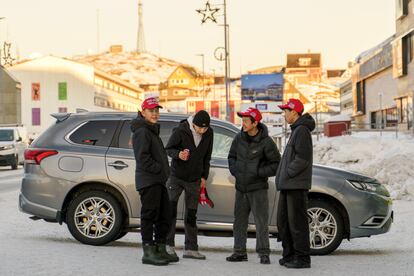
Javier Arnaut, a professor at the University of Greenland specializing in economics and natural resources, offers a perspective that could reshape Greenland’s economy and society: the island’s rich subsoil. Due to the sparse tree cover, much of Greenland’s landscape is easily accessible for exploration. Beneath its frozen surface lie not only oil, gas, copper, iron, and gold, but also rare materials and minerals like neodymium, a crucial component for electric car motors and wind turbine magnets.
In the southern part of the island, near Narsaq — home to a population of just 3,000 people, most of whom work in fishing — lies one of the largest neodymium deposits in the world. This mine alone, according to Arnaut, could generate value equivalent to 25% of the annual Danish aid provided to Greenland. However, in 2021, the Inuit Ataqatigiit won the election largely because they opposed the development of this project, citing concerns over its potential ecological impact. “It’s not just about that,” Arnaut explains. “The Inuit don’t have a mining tradition, and if this project were to go ahead, workers would have to be brought in from outside. There’s no housing for them, and it would possibly contaminate the fisheries.”
Some have interpreted this decision as a schizophrenic gesture: the aim is independence, yet the country is willing to forgo a massive source of resources. Arnaut, however, does not see it that way: “This capitalist hunger doesn’t exist here, at least not yet. It’s not part of the Inuit culture, which isn’t driven by short-term profit. I don’t know if that’s good or bad, but it is what it is.” Interestingly, the shares of ETM, the Australian company holding rights to the mine — still embroiled in legal disputes with the Greenlandic government — have skyrocketed since Trump once again set his sights on Greenland.
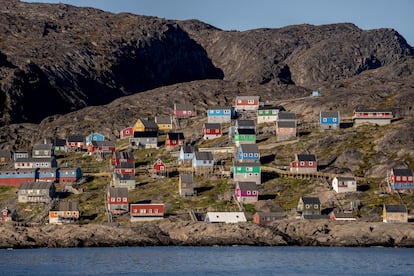
But is that what Trump really wants? Mines? Or is this just another chapter in the imperialist agenda he seems to be pursuing, with aspirations extending beyond Greenland to Panama and Canada? Jakob Kirkegaard of the Bruegel Institute believes Trump’s ultimate interest in Greenland is not entirely clear: “Trump’s interest in Greenland started with his love for maps. He saw that Greenland is large and strategically positioned between the U.S. and Russia. He wants Greenland, or something related to it. But I don’t think he’s very rational. He doesn’t care that Denmark is a U.S. ally with a treaty in place. And he doesn’t realize that if he imposes tariffs on Denmark, he will face the European counterpart.”
Arnaut points out that the melting ice caused by climate change has opened up new trade routes — and will open more in the years to come — through the Arctic, with the U.S. seeking access from its side, the one occupied by Greenland. He adds that the current U.S. base in Greenland, located in the northern part of the island, houses a missile detection system. One of Trump’s potential goals could be to expand such bases, giving the U.S. more advanced and precise missile detection capabilities aimed at Russia or China. “Given the state of the world today, anything can happen,” Arnaut remarks.
Greenland has, perhaps unwittingly, become a geostrategic linchpin and a logistical hub of growing significance. This remote, frozen expanse now finds itself intersecting several of the world’s critical crossroads, leaving its 57,000 inhabitants grappling with a future that remains anything but clear.
Sign up for our weekly newsletter to get more English-language news coverage from EL PAÍS USA Edition
Tu suscripción se está usando en otro dispositivo
¿Quieres añadir otro usuario a tu suscripción?
Si continúas leyendo en este dispositivo, no se podrá leer en el otro.
FlechaTu suscripción se está usando en otro dispositivo y solo puedes acceder a EL PAÍS desde un dispositivo a la vez.
Si quieres compartir tu cuenta, cambia tu suscripción a la modalidad Premium, así podrás añadir otro usuario. Cada uno accederá con su propia cuenta de email, lo que os permitirá personalizar vuestra experiencia en EL PAÍS.
¿Tienes una suscripción de empresa? Accede aquí para contratar más cuentas.
En el caso de no saber quién está usando tu cuenta, te recomendamos cambiar tu contraseña aquí.
Si decides continuar compartiendo tu cuenta, este mensaje se mostrará en tu dispositivo y en el de la otra persona que está usando tu cuenta de forma indefinida, afectando a tu experiencia de lectura. Puedes consultar aquí los términos y condiciones de la suscripción digital.
More information
Archived In
Últimas noticias
The day the creator of Tetris met the inventor of the Rubik’s Cube: ‘We have to look for entertainment that challenges us’
Emily Goligoski, researcher: ‘I have a policy for the use of devices in class. How can I compete against dopamine while teaching some theory?’
‘Sextette’: The story of Mae West’s final madcap movie
When Judas Priest were accused of inducing two fans to kill themselves: A chronicle of the most infamous trial in music history
Most viewed
- The number of international tourists going to the US is decreasing, with one exception: Mexico
- A mountaineer, accused of manslaughter for the death of his partner during a climb: He silenced his phone and refused a helicopter rescue
- Belle da Costa, the woman who concealed her origins in 1905 and ended up running New York’s most legendary library
- Liset Menéndez de la Prida, neuroscientist: ‘It’s not normal to constantly seek pleasure; it’s important to be bored, to be calm’
- An interstellar traveler is getting closer to Earth than ever before: How to observe comet 3I/ATLAS











































